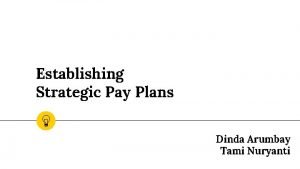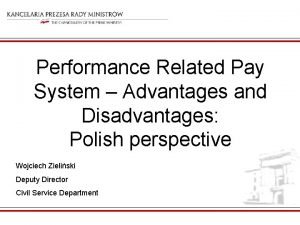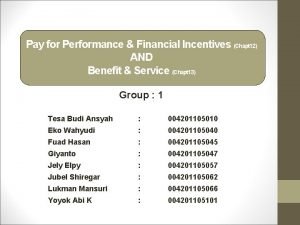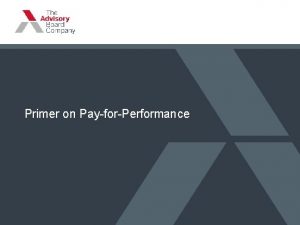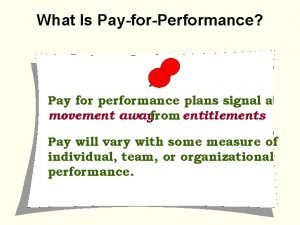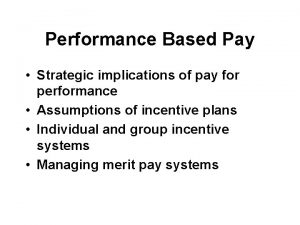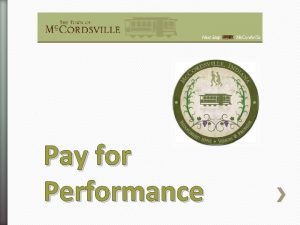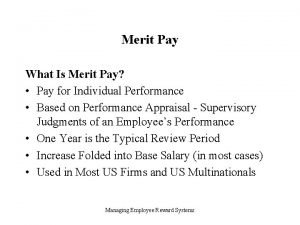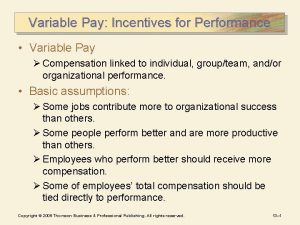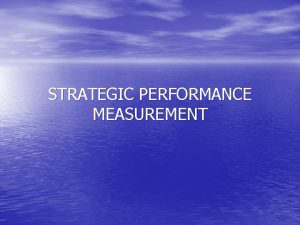STRATEGIC CHOICES IN PAYFORPERFORMANCE PROGRAMS Pay for Performance


























- Slides: 26

STRATEGIC CHOICES IN PAY-FOR-PERFORMANCE PROGRAMS Pay for Performance Summit February 6, 2006 Professor James C. Robinson University of California, Berkeley

OVERVIEW Goals of pay-for-performance programs Choices among metrics Choices among structures Matching choices to goals Making choices based on goals

STRATEGIC DESIGN IN PAY FOR PERFORMANCE Pay-for-Panacea? Three goals for pay-for-performance Design choices: metrics Design choices: structure

Pay-for Panacea: Measure Everything? “Performance” is multi-dimensional: Lab tests, lab values, preventive screening, tobacco counseling, body mass index measurement, post-surgical complications, severity-adjusted mortality, use of electronic health record, e-prescribing, generics as percent of prescriptions, post-AMI follow-up Sensitive caring holistic evidence-based culturally-appropriate cost-effective well baby visits

Pay-for-Panacea: Promise Everything? P 4 P programs have ambitious goals: Reward quality, improve quality, encourage IT diffusion, reduce costs, reduce administrative hassle, adjust metrics for risk, reduce disparities, minimize gaming, foster innovation Promote mutual understanding, life, liberty, world peace, and better coffee

Clarity is a Virtue The effectiveness of P 4 P programs will be enhanced to the extent: We are clear on goals We are clear on choice of metrics We are clear on choice of structure We are clear on how choices among metrics and structure reflect priorities among goals

Three Goals for P 4 P Programs Reward Higher Quality Fund Quality Investments P 4 P Program Efficiency Physicians who provide better care processes, and/or whose patients achieve better outcomes, will earn more than other physicians P 4 P bonus payments will help motivate and finance investments in quality improvement, including evidencebased guidelines and information technology The administration of P 4 P programs will be financed by savings generated by the program, and the burden of data collection and analysis will be modest

Four Design Alternatives: Metrics Number of metrics Measure Of Quality Number of What type of metrics to be quality measure used for payment is to be bonus: emphasized? Many or few? Outcomes or processes? Information Technology Costs of Care Should IT capabilities and use be included in P 4 P bonus? Should measures of economic efficiency be included in P 4 P? Yes or no?

Four Design Alternatives: Structure Relative Size Of Bonus Sources of Data Should the P 4 P bonus be a large or small percent of total physician compensation? Should data be obtained from one or multiple insurers (and then combined)? Should the medical group or individual physician be rewarded? Should P 4 P reward high performance or improvement in performance? Large or small? One or multiple? Group or individual? Performance or improvement? Unit of Performance or Observation Improvement

METRICS: Many or Few Measures? Use of many different performance metrics encourages progress on all fronts, reduces gaming (work-to-metric), and has face validity (quality is multi-dimensional) But use of many metrics reduces reward for any one metric (and hence for all? ), diffuses focus, and increases data burden 10

METRICS: Process or Outcome Measures? Outcome measures have face validity, avoid “cookbook medicine”, but impose severe measurement challenges Must be severity adjusted Event may be rare or change only slowly Depend on patient education, compliance, baseline health status, and other factors beyond MD control Process measures directly reward what physicians do, benchmarked to evidence-based guidelines 11

METRICS: Include Information Technology? Should IT capabilities be included explicitly in metrics used as the basis for P 4 P bonus? Yes: Jump-starting IT adoption lays the foundation for all P 4 P initiatives, creates business case for IT investment, and reduces cost of P 4 P program itself No: IT is not quality, and is rewarded indirectly through rewards for quality 12

METRICS: Efficient Use of Resources? Should P 4 P programs reward efficiency (low costs) as one dimension of performance? If cost control is not rewarded in P 4 P, it will be imposed in less pleasant manners: Consumer copays; provider utilization management Efficiency improvements might fund P 4 P program But cost is not quality; inclusion may undermine legitimacy of P 4 P programs in eyes of consumers 13

STRUCTURE: Large or Small Bonus? If performance bonus is to be large, base compensation must be small Large bonus relative to base increases incentive for physicians to do what we want them to do But also for risk avoidance, work-to-metric Small bonus creates signal of concern for quality without imposing great risk on MD 14

STRUCTURE: Data from One or Many Insurers? Combining claims data from multiple insurers increases precision (sample size), standardizes metrics, reduces invalid “dueling scorecards” for same providers But combining claims may slow P 4 P development (lowest common denominator) and inhibit experimentation Anti-trust concerns about insurers? 15

STRUCTURE: Medical Group or Individual MD? Measuring performance of MD groups improves precision (sample size for each disease), highlights role of systems (IT, clinical guidelines, peer review) in quality But group measurement/reward diffuses incentives for individual physicians Most physicians are not in large groups 16

STRUCTURE: Performance or Improvement? Rewarding performance moves money to providers with best performance, regardless of how achieved Some groups achieve quality via effort Others fund quality from monopoly pricing Better outcomes due to more educated patients? Moving money from low to high performers could increase disparities within system 17

Performance or Improvement? (Continued) Rewarding improvement encourages and finances lagging groups/MDs to improve But this may reward low quality providers and undermine legitimacy of P 4 P program More potential for improvement among initially low-quality than initially high-quality providers Reward for performance indirectly rewards improvements in performance 18

Aligning Choice of Metrics with Pay-for-Performance Goals Reward Quality Fund Quality Investments Administrative Efficiency Many Few Process or outcome measures of quality? Outcome Process Reward information technology? No Yes Reward efficient use of resources (cost) No Yes Number of metrics: Many or few?

Aligning Structural Choices with Pay-for-Performance Goals Reward Quality Fund Quality Investments Administrative Efficiency Bonus as % of total pay: large or small? Small % of Total Large % of Total Small % of Total Data source: single or multiple insurers? Multiple insurers Unit of observation: group or individual? MD Group and Individuals MD Group Level of Performance Improvement In performance Level of Performance Reward performance or improvement?

Placing Relative Weights on P 4 P Goals Reward Higher Quality Fund Quality Investments P 4 P Program Efficiency Weight = 3 Weight = 2 Weight = 1 P 4 P is P 4 P Quality improvement (including IT) can be funded from multiple sources. Rewarding low-quality providers (who improve) over high quality providers lacks legitimacy Low administrative and financial burden of P 4 P is a virtue, but does not dominate achievement of quality goals Face legitimacy, best long term incentives

Evaluating Choice of Metrics in Light of (weighted) P 4 P Goals Choice of Metric Weighted Relative Score Conclusion for Design Metrics: many/few? 3/3 Outcomes/processes? 3/3 IT adoption: yes/no? 3/3 Efficiency: yes/no? 3/3 With reasonable choice of goals and priorities (weights) among them, no clear answers emerge for choice of metrics. Conclusion: multiple approaches, fostering experimentation, are best at this time.

Evaluating Choice of Structure in Light of (weighted) P 4 P Goals Choice of Structure Bonus as % of total: Small/large? Insurer data sources: Multiple/single? Unit of MD analysis: Group/individual? Reward: performance/ improvement? Weighted Relative Score 4/2 6/0 5/1 4/2 Conclusion for Design With reasonable choice of goals and priorities (weights) among them, structural choices ideally should favor small bonus, multiple insurer data, group metrics/reward, and reward for performance over improvement.

Conclusion: Metrics Diversity and experimentation is to be encouraged in choice of metrics, as there are no decisive advantages at this time Number of metrics: many or few Measure of quality: process or outcome Information technology: include or exclude Economic efficiency: include or exclude 24

Conclusion: Structure With choice of structure, however, clear advantages emerge: Bonus as % of total compensation: small Insurers as data source: multiple insurers MD group or individual: MD group Performance or improvement: performance But regional and organizational diversity will ensure continued structural diversity 25

Conclusion: Pay-for-Clarity Diversity and experimentation in P 4 P programs are to be encouraged But P 4 P cannot be all things to all people Difficult choices of metrics and structure Clarity of goals will help with choices Implementation depends on feasibility, varying across organizations and regions 26
 Overview of software engineering
Overview of software engineering How much does wanda earn per hour?
How much does wanda earn per hour? Designing pay levels
Designing pay levels Demotivators and edward deci theory
Demotivators and edward deci theory Chapter 1 gross income answers
Chapter 1 gross income answers Consequences of an internally aligned structure
Consequences of an internally aligned structure Multinational strategies and structures
Multinational strategies and structures Strategic meetings management program
Strategic meetings management program Establishing strategic pay plans
Establishing strategic pay plans Ranking method of job evaluation
Ranking method of job evaluation Fine tune pay rates
Fine tune pay rates What is a strategic perspective
What is a strategic perspective Job evaluation in hrm
Job evaluation in hrm Establishing strategic pay plans
Establishing strategic pay plans 5 essentials of pay for performance
5 essentials of pay for performance Advantages and disadvantages of performance related pay
Advantages and disadvantages of performance related pay Pay for performance adalah
Pay for performance adalah Strategic fit vs strategic intent
Strategic fit vs strategic intent Puppy dog ploy
Puppy dog ploy Strategic management and strategic competitiveness
Strategic management and strategic competitiveness Tows matrix
Tows matrix Scope of strategic fit
Scope of strategic fit Strategic management performance system
Strategic management performance system Performance management and strategic planning
Performance management and strategic planning Strategic e-marketing and performance metrics
Strategic e-marketing and performance metrics Strategic fit
Strategic fit Strategic e-marketing and performance metrics
Strategic e-marketing and performance metrics








